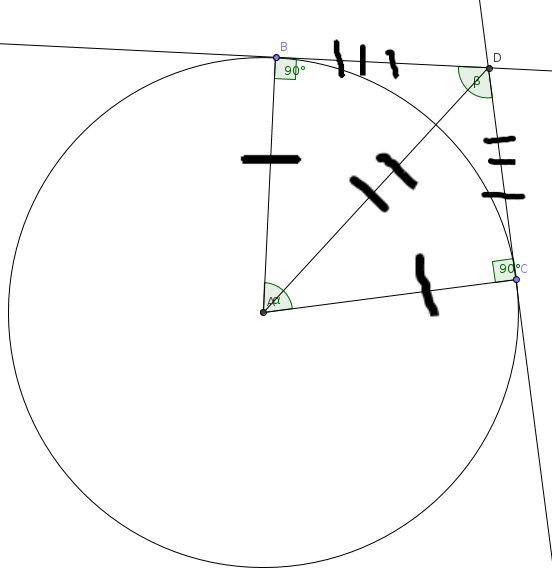Area Between Two Tangents on a Circle Equation
Here is an equation I derived in a simple manner for finding the area between two tangents on a circle in terms of the radius if given their angle of intersection, as shown above.
In accordance with this diagram:

We can prove with SSS or SAS that the two triangles are congruent. Here, beta is the angle of intersection and beta is the supplement of alpha. All I am doing is finding the areas of both triangles and subtracting from it the area section of our circle, whatever remains is the area between the curves. Nothing fancy, but it is nice to generalize something, and it might come in handy for someone somewhere.
No vote yet
1 vote
Easy Math Editor
This discussion board is a place to discuss our Daily Challenges and the math and science related to those challenges. Explanations are more than just a solution — they should explain the steps and thinking strategies that you used to obtain the solution. Comments should further the discussion of math and science.
When posting on Brilliant:
*italics*or_italics_**bold**or__bold__paragraph 1
paragraph 2
[example link](https://brilliant.org)> This is a quote# I indented these lines # 4 spaces, and now they show # up as a code block. print "hello world"\(...\)or\[...\]to ensure proper formatting.2 \times 32^{34}a_{i-1}\frac{2}{3}\sqrt{2}\sum_{i=1}^3\sin \theta\boxed{123}Comments
This formula would look a little neater if you'd have expressed all angles in radians.
Log in to reply
@Deeparaj Bhat Right. So I guess: tan(2β)r2−2r2α. You are right, it looks a lot nicer. I tried also getting a common denominator, but that looks even worse than using degrees. Thank you, sir.
Log in to reply
@Drex Beckman On plugging in β, the formula becomes,
2r2⋅(tan2α−2α)
Log in to reply
@Deeparaj Bhat Can you please tell me how you derived that? Sorry, I'm lacking in maths. Is there an identity you used? Also, am I doing something wrong? I tried this with my question: 2r2(tan(2α)−2α) where α=0.479965radians, and I got an answer of ≈0.00236, which is exactly half the answer. I think it should be r squared itself, not divided by two, right? I tried this with different r, too. Thanks for your help, it is really appreciated!
Log in to reply
Sorry, my bad. It was supposed to be r2(tan(2α)−2α), like you said.
I used the following two facts for deriving it:
α+β=π tan(2π−x)=cotx
The first follows by the fact that sum of angles in a quadrilateral ( here ABCD) is 2π and since ∠ACD=∠ABD=2π
The second is a well known identity which you can find in one of wikis on Brilliant.
Log in to reply
Okay, I get it now. I don't really remember lots of trig identities, so I should obviously review them. :P But you did a great job simplifying it. It really does look a lot more beautiful that way. Thanks! :D
Log in to reply
In fact, most of the level 5 geometry problems can be solved (almost) exclusively by using trig identities!
Log in to reply
Seriously?! Good to know, man. I learned them at school a few years ago, and never used them again. But that was before I thought mathematics was fun. Too bad I didn't get interested in it earlier, because I am way far behind people like you, also I think most of the people on here are smarter than me. xD